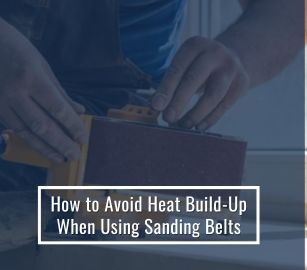
How to Avoid Heat Build-Up When Using Sanding Belts

Sanding belts are necessary tools for smoothing and shaping a wide range of materials like wood, metal, and other materials. During the sanding process, too much heat is produced, which can affect the material as well as the tool. It may produce uneven surfaces, rapidly wearing out the sanding belt and burning the workpiece. Overheating can also reduce the lifespan of sanding belts.
This article will go through all about how to use sanding belts without creating heat build-up.
10 Tips To Use Sanding Belts Without Heat Build-Up
-
Selecting the right grit: choosing the right grit is essential to avoid excessive heat build-up. For efficient removal and shaping of material, start with a coarser grit. For a smooth finish, enhanced to finer grits. Make sure not to use very fine grit, which enables friction and leads to overheating.
-
Applying the right pressure: applying the right pressure while sanding will also help prevent heat build-up. Ensure to apply gentle and even pressure to avoid friction, which significantly causes excessive heat. Make sure not to dwell in one spot; this can result in localized overheating and burning. Ensure that the sanding belt keeps on moving for evenly distributing heat.
-
Maintain belt tracking: to prevent heat building in the workpiece, ensure to maintain proper belt tracking. Always check that the sander is perfectly fitted to the rollers to reduce friction. In order to keep the belt running off-center, adjust the tracking system. This causes the heating and burning of a workpiece.
-
Regularly cleaning the belt: always maintain the belt by keeping it clean. Regularly cleaning will help in reducing the accumulated dust and debris build-up in the belt, which increases friction and generates heat. Regular upkeep of your belt sander will not only help in reducing heat buildup but also lead to efficient cutting.
-
Maintain the right speed: always adjust the speed while sanding to prevent heat build-up. Higher speed can lead to more heat generation, particularly when working with softer materials. Make sure to match the speed of the sander with the required finish.
-
Use lubricants: using good-quality lubricants or cooling agents will also help in reducing heat. To prevent material from burning, use water-based coolants. Compressed air can also be used to avoid heat generation and cooling down the workpiece and the sanding belt.
-
Take short breaks: while sanding with belt sanders, it's always a good option to take short breaks in between the process. Continuously working will result in overheating of the material as well as the belt sander. Taking breaks allows some time for the workpiece and sander to cool down.
-
Alternative method: It is always a good idea to explore new methods or ways to do certain projects. For certain applications, find new ways or tools that help in reducing heat build-up. For example, disc sanders and orbital sanders can be used in place of belt sanders as they will evenly distribute the heat and prevent your workpiece from getting damaged.
-
Maintain and frequent upkeep of sander: regularly maintaining your sander will ensure optimal performance and is crucial for preventing heat build-up. Ensure to clean dust and debris from the inside of your sander that can clog airflow and restrict heat dissipation. It is also crucial to examine your sander for any breakage or any wear and tear that will increase friction and overheating and replace that part for efficient productivity. Frequently maintaining and upkeep will not only help in enhanced performance but also increase the durability of the sander.
-
Work environment: keeping your work environment well-ventilated plays a crucial role in preventing heat build-up while sanding. Enough ventilation keeps heat from building up in the surrounding region and aids in dissipating heat produced during the sanding operation. Make sure your workstation is properly ventilated by opening windows, using fans, and through proper airflow, ensuring that your working space is comfortable and enhancing your sanding process.
By implementing above mentioned tips into your sanding process, you’ll gain a better understanding, and you will be able to enhance your ability to control heat built-up and achieve optimal results.



































































